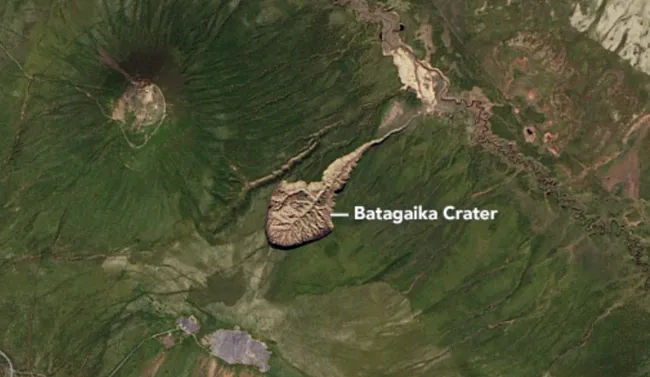The “Gateway to the Underworld,” a massive crater in Siberia’s permafrost, is expanding by as much as 35 million cubic feet (1 million cubic meters) each year as the permafrost melts, according to a new study.
Officially known as Batagai Crater (also spelled Batagayka), the crater has a rounded rock face that was first detected in satellite images in 1991 after the collapse of part of a hillside on the Yaniya Plateau in northern Russia’s Yakutia. This collapse exposed layers of permafrost on the remaining part of the hillside that had been frozen for up to 650,000 years; this was the oldest permafrost in Siberia and the second oldest in the world.
New research suggests that the rock, or Batagai main shaft, is retreating at a rate of 40 feet (12 meters) per year due to thawing permafrost. The collapsed portion of the hillside, buried 180 feet (55 m) below the main wall, is also rapidly melting and consequently collapsing.
“Rapidly melting permafrost features are common and are observed to increase in arctic and subarctic ice-rich permafrost regions,” the research team wrote in a study published online March 31 in the journal Geomorphology. he wrote. However, the amount of ice and sediment lost from the Batagaya megaslide is “extraordinarily high” due to the size of the depression, which spans 3,250 feet (990 m) wide by 2023.
Its width in 2014 was 2,600 feet (790 m) and has increased by 660 feet (200 m) in less than 10 years. Researchers already knew it was growing, but this was the first time they measured the volume of melt flowing out of the crater. They did this by examining satellite images, field measurements and laboratory data on samples taken from Batagay.
The results showed that an area of ice and sediment equivalent to more than 14 of the Great Pyramids of Giza melted following the collapse of the megaslide. Melt rates have remained relatively stable over the past decade; It occurred mostly along the front wall on the western, southern, and southeastern edges of the crater.
Source: Port Altele
